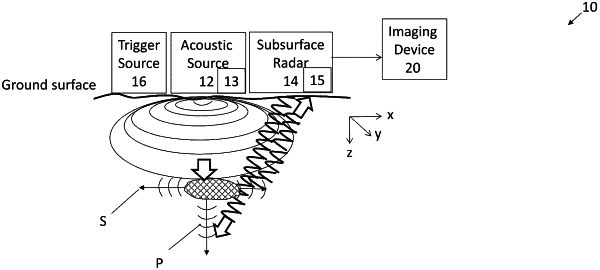| CPC G01V 1/284 (2013.01) [G01V 3/083 (2013.01); G01V 3/12 (2013.01); G01V 3/36 (2013.01); G01V 2003/084 (2013.01); G01V 2003/085 (2013.01); G01V 2003/086 (2013.01)] | 7 Claims |

|
1. A method for determining a subsurface feature, comprising:
transmitting a surface penetrating radar (SPR) signal at a ground surface;
receiving a response signal that includes elastic waves of a lower frequency acoustic source that interact with the SPR signal;
rapidly processing the response signal including the SPR signal modified by the interaction with the elastic waves; and
determining a physical characteristic of the subsurface feature from the response signal, wherein the elastic waves are produced by at least one vibrating source that insonifies subsurface features, and wherein the method further comprises performing a rapid imaging of a dynamic scattered wave field generated by the insonification, wherein the elastic waves include an induced low frequency continuous elastic wave propagating away from a focus region measured using the SPR signal so that at various phases of a low frequency modulation, pulsed waves are sent into the ground surface and back-scattered signals are received and used to create a time sequence of images formed by the SPR signal.
|